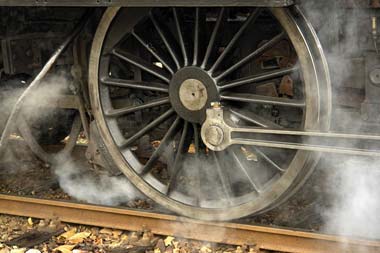Wheels of a steam engine; photo by josef.stuefer on Flickr (noncommercial use permitted with attribution / no derivative works).
Texas Official State Railroad
The Texas state railroad was designated the official railroad of Texas in 2003. All Railroad Symbols
Trains have rolled along the Texas State Railroad Since 1896. The historic state railroad is still maintained as a fully self-contained railroad system.
HOUSE CONCURRENT RESOLUTION
WHEREAS, The State of Texas has customarily recognized a variety of official state symbols as tangible representations of the state's historical and cultural heritage; and
WHEREAS, The Texas State Railroad, an East Texas fixture for more than a century, had its origins in the iron-industry boom that East Texas experienced in the 1870s and 1880s; in 1875 the state legislature authorized construction of a new penitentiary near Rusk in order to develop the iron-ore resources of the area, as well as to relieve overcrowding at the penitentiary in Huntsville; the ensuing iron works at the East Texas Penitentiary provided material for the present State Capitol, including the iron that was used in the building's columns and dome; and
WHEREAS, To facilitate the transport of iron ore for the smelter and foundries, as well as timber for the prison's sawmill, construction was begun in 1881 on a line known officially as the Texas State Railroad, and by 1909 the road had been extended to Palestine in adjacent Anderson County; and
WHEREAS, In addition to hauling raw materials to the penitentiary, the railroad offered regular passenger and freight service from 1907 to 1921; prison inmates, who had constructed the entire line, made up the train crew, except for the engineer, during much of this period; and
WHEREAS, The iron works at the prison closed in 1913, and eight years later the state began leasing the track of the Texas State Railroad to private companies; over the next half-century the line served in particular to move lumber and timber products; and
WHEREAS, In 1972, after most of the road had remained unused for several years, the Texas Legislature conveyed the line to the Parks and Wildlife Department; at the urging of rail enthusiasts, and after studying the feasibility of such a project, it was decided to restore the line as part of a state historical park and to dedicate the complex to the preservation and interpretation of the country's railroad heritage; and
WHEREAS, On July 4, 1976, as part of the nation's Bicentennial celebration, the Texas State Railroad State Historical Park opened to the delight of countless citizens across the state; in 2002, more than 130,000 people visited the park, including 83,000 from outside the area; of those visitors, 41,110 took a ride on one of the trains that makes the run through the piney woods and rolling hardwood creek bottoms between Palestine and Rusk; and
WHEREAS, A fully self-contained system, the Texas State Railroad operates four steam engines and four antique diesel locomotives; in addition, it maintains a complete steam-engine restoration shop, 29 miles of track, and 24 bridges, including one over the Neches River; and
WHEREAS, Included in the railroad's stock are Steam Engine No. 201, donated by the City of Abilene and once used by the Texas & Pacific Railroad; Steam Engine No. 300, donated by Temple Industries in Pineland; Steam Engine No. 400, purchased from the Magma Copper Mine in Magma, Arizona, and once used by the Tremont & Gulf Railway in Central Louisiana; Steam Engine No. 500, owned at one time by the City of San Angelo; and Steam Engine No. 610, operated by the Texas & Pacific between Shreveport and El Paso until 1950 and displayed in Fort Worth for a number of years; in the 1970s the publisher and philanthropist Amon G. arter, Jr., financed the restoration of No. 610, and the engine became one of two that pulled the Freedom Train through Texas during the Bicentennial; and WHEREAS, Over the years, the railroad has received significant attention in many quarters and has been featured in television series, documentaries, commercials, music videos, and full-length films; and
WHEREAS, The Texas State Railroad and its historical park have contributed greatly to the prosperity of the surrounding area; in 2002 they injected nearly $1.5 million into the local economy, generated more than $4.6 million in sales, and produced a more than $1.8 million impact on the income of local residents; and
WHEREAS, Deeply rooted in the life and industry of East Texas, the Texas State Railroad is today one of the largest steam train operations in the country; through its preservation program, its excursion tours, and a wide variety of educational efforts, the railroad constitutes an outstanding asset to the Lone Star State; now, therefore, be it
RESOLVED, That the 78th Legislature of the State of Texas hereby designate the Texas State Railroad as the official Railroad of Texas.

